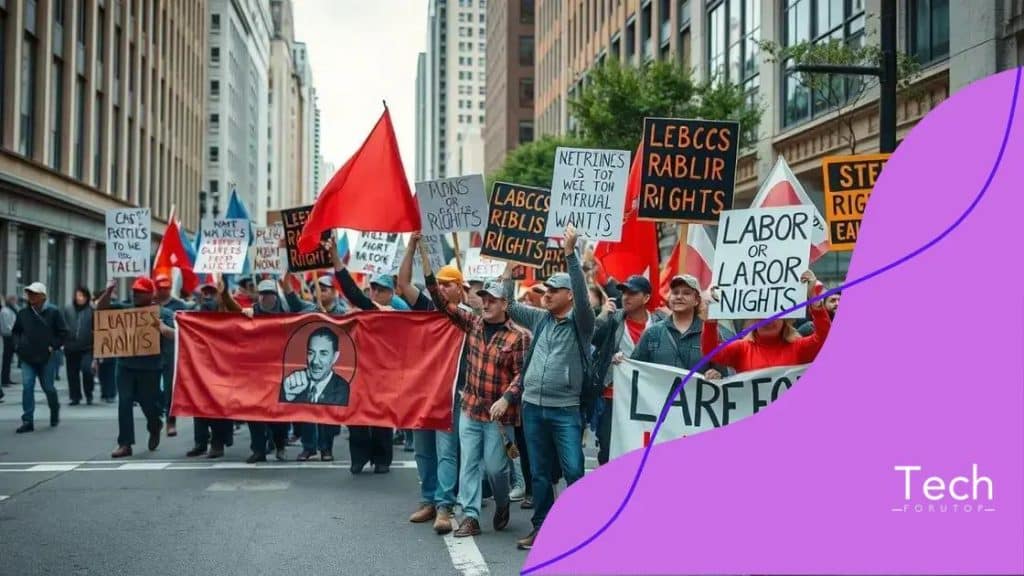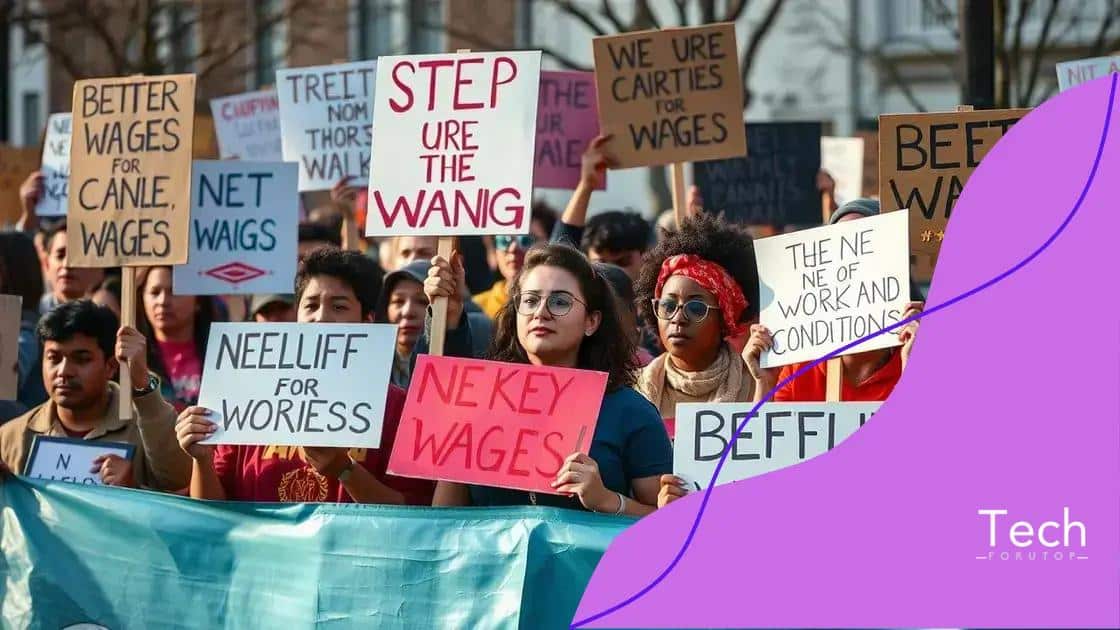Public labor rights protests: a growing movement

Public labor rights protests are movements organized by workers to demand fair wages, safe working conditions, job security, and better benefits, significantly enhanced by social media and technology for mobilization.
Public labor rights protests have become a significant part of the global conversation on worker rights. But what drives this movement and why should you pay attention? Let’s dive in and explore the changing landscape of labor rights.
Understanding public labor rights
Understanding public labor rights is essential in today’s world where worker empowerment is gaining more attention. Labor rights refer to the legal and human rights related to work, including fair wages, safe working conditions, and the right to organize. These rights are crucial for ensuring that workers are treated with respect and dignity.
Key Components of Labor Rights
Public labor rights encompass various aspects that protect workers in different sectors. They serve as the foundation for fair treatment at the workplace. Among these rights, we can highlight:
- Right to Fair Compensation: All workers deserve to be paid fairly for their labor.
- Right to Safe Working Conditions: Employees should work in environments that are free from hazards.
- Right to Join Unions: Workers have the right to form and join unions to collectively bargain for better conditions.
- Right to Non-Discrimination: Every worker should be treated equally, regardless of race, gender, or background.
These components form the basis of labor rights and help to maintain a balance between employees’ needs and employers’ demands. In many countries, public labor rights have evolved through decades of activism and advocacy.
As we delve deeper into the world of labor rights, it’s evident that understanding the historical context is crucial. Many labor movements have emerged in response to poor working conditions and unfair treatment in the workforce. Movements advocating for labor rights have often taken to the streets, drawing public attention to their causes.
Historical context of labor rights protests
The historical context of labor rights protests is vital for understanding how the modern labor movement has evolved. These protests have a rich history that reflects the ongoing struggle for fair treatment and recognition of workers’ rights.
Early Labor Movements
In the 19th century, industrialization led to harsh working conditions. Workers faced long hours, low pay, and unsafe environments. Early labor movements began to organize in response to these issues, aiming for better wages and safety standards. Important events like the Haymarket Affair in 1886 highlighted the fight for labor rights and set the stage for future movements.
Key Milestones
Throughout history, several significant milestones have defined labor rights protests:
- The Formation of Unions: Labor unions became essential in advocating for workers’ needs.
- The 40-Hour Work Week: Campaigns for reasonable work hours significantly changed labor standards.
- Minimum Wage Laws: The introduction of minimum wage laws helped ensure fair compensation.
- Occupational Safety and Health Administration (OSHA): Established to protect workers from job hazards.
These milestones reflect the ongoing efforts to improve working conditions. Each protest and movement adds to the narrative, showing how workers unite to address grievances.
The late 20th century marked a resurgence of labor protests. Issues like globalization, economic inequality, and the gig economy prompted new waves of activism. Workers are increasingly mobilizing for rights that adapt to the changing labor landscape.
Key demands of recent protests

The key demands of recent protests have significantly shaped the discussion surrounding labor rights. Workers across various sectors are coming together to voice their needs, which reflect a broader desire for equity and justice in the workplace.
Common Demands
Recent protests have highlighted several crucial demands from workers. This reflects not only their immediate needs but also their vision for a fairer future. Some of the primary demands include:
- Higher Wages: Many workers demand fair compensation that reflects the cost of living and their contributions.
- Improved Working Conditions: Protests often call for safer workplaces that prioritize the health and well-being of employees.
- Job Security: Workers are advocating for policies that protect them from layoffs and ensure stable employment.
- Better Benefits: This includes comprehensive healthcare, paid sick leave, and retirement plans.
These demands are not just isolated issues; they are interconnected and represent a collective push for dignity and respect in the workplace. As workers rally together, the synergy of their voices creates a stronger impact.
Furthermore, these protests often shine a light on systemic issues such as inequality and discrimination. Many activists emphasize that labor rights are human rights and that every worker’s voice matters.
The role of social media in mobilization
The role of social media in mobilization has become increasingly important in recent years, especially during labor rights protests. Social media platforms allow individuals to connect, share their stories, and organize events swiftly.
Instant Communication
One of the key advantages of social media is its ability to facilitate instant communication. Workers can quickly disseminate information about upcoming protests or related activities. This immediacy helps create a sense of urgency and engagement amongst potential participants.
Building Awareness
Through platforms like Twitter, Facebook, and Instagram, activists are able to reach a wider audience. They can share educational content about labor rights, highlight injustices, and promote upcoming events. This widespread sharing leads to greater public awareness and support for labor issues.
- Hashtags: Unique hashtags help to gather conversations around specific issues, making it easier to track discussions and mobilize support.
- Live Updates: During protests, live updates allow people to share real-time experiences, drawing more attention to their causes.
- Community Building: Social media helps in forming communities that unite individuals with shared goals, increasing overall participation.
- Fundraising: Platforms like GoFundMe or Patreon allow for quick fundraising efforts to support protest actions.
Moreover, social media acts as a tool for solidarity. When individuals see others voicing their concerns, it encourages them to join in and be part of the conversation. The visual nature of social media, with photos and videos shared during protests, further amplifies their impact.
In essence, the digital age has transformed how labor movements operate, making social media a vital element for organizing and mobilizing supporters. This connection can greatly amplify the voices of those advocating for labor rights.
Future outlook for labor rights movements
The future outlook for labor rights movements appears increasingly dynamic and vital as workers continue to advocate for their rights. With ongoing changes in the economy and work environment, the labor movement is poised for significant evolution.
Emerging Trends
As more workers join the gig economy, new challenges and opportunities arise. Labor movements are adapting to these changes by addressing issues specific to gig workers, such as job security and access to benefits. Activists are pushing for policies that extend traditional labor protections to these emerging sectors.
Increased Solidarity
Worker solidarity is also strengthening across various sectors. Movements are beginning to unite, recognizing that their struggles are interconnected. Collaborations between labor unions and community organizations are becoming more common. This synergy amplifies their voices and allows for collective bargaining on a larger scale. Some key aspects include:
- Cross-Sector Collaboration: Unions and activist groups are joining forces to tackle issues like climate change alongside labor rights.
- Global Movements: Labor rights advocates are connecting across borders, learning from international successes and challenges.
- Using Technology: Digital tools and platforms are helping to mobilize and organize more effectively than ever before.
- Focus on Equity: Movements are emphasizing equity and inclusion, particularly for marginalized and underrepresented workers.
These changes signal a potential shift in the labor landscape where workers are more empowered. As they continue to organize and advocate for their rights, they bring attention to social justice issues and push for better working conditions.
Ultimately, the adaptations and innovations seen in labor rights movements will likely shape how workers interact with employers and advocate for their needs in the future. The drive for change remains strong as collective efforts grow.
FAQ – Frequently Asked Questions about Labor Rights Movements
What are the main goals of recent labor rights protests?
Recent protests mainly aim for fair wages, improved working conditions, job security, and better benefits for all workers.
How has social media impacted labor rights mobilization?
Social media helps to quickly spread information, allowing workers to organize efficiently and raise awareness about their causes.
What role does technology play in supporting labor rights?
Technology enables better communication and coordination among workers, enhancing solidarity and facilitating fundraising efforts.
Why are collaboration and community building important in labor movements?
Collaboration allows different groups to unite their efforts, amplifying their voice and impact on labor rights issues.





